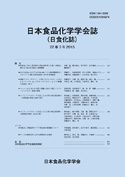Volume 22, Issue 3
Displaying 1-8 of 8 articles from this issue
- |<
- <
- 1
- >
- >|
Regular articles
-
Article type: Article
2015 Volume 22 Issue 3 Pages 154-162
Published: December 24, 2015
Released on J-STAGE: January 27, 2017
Download PDF (1038K) -
Article type: Article
2015 Volume 22 Issue 3 Pages 163-169
Published: December 24, 2015
Released on J-STAGE: January 27, 2017
Download PDF (903K) -
Article type: Article
2015 Volume 22 Issue 3 Pages 170-174
Published: December 24, 2015
Released on J-STAGE: January 27, 2017
Download PDF (502K) -
Article type: Article
2015 Volume 22 Issue 3 Pages 175-180
Published: December 24, 2015
Released on J-STAGE: January 27, 2017
Download PDF (5277K) -
Article type: Article
2015 Volume 22 Issue 3 Pages 181-187
Published: December 24, 2015
Released on J-STAGE: January 27, 2017
Download PDF (894K) -
Article type: Article
2015 Volume 22 Issue 3 Pages 188-194
Published: December 24, 2015
Released on J-STAGE: January 27, 2017
Download PDF (869K)
Notes
-
Article type: Article
2015 Volume 22 Issue 3 Pages 195-199
Published: December 24, 2015
Released on J-STAGE: January 27, 2017
Download PDF (708K) -
Article type: Article
2015 Volume 22 Issue 3 Pages 200-205
Published: December 24, 2015
Released on J-STAGE: January 27, 2017
Download PDF (650K)
- |<
- <
- 1
- >
- >|
